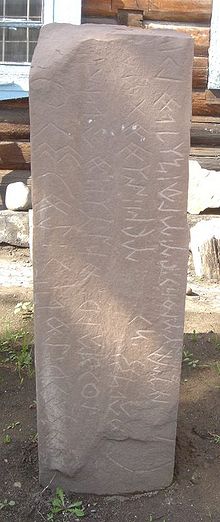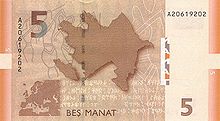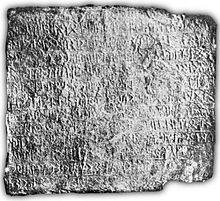- Old Turkic alphabet
-
Old Turkic script 
Type Alphabet Languages Old Turkic Time period 7th to 13th centuries Parent systems Proto-Sinaitic- Phoenician
- Aramaic
- Syriac
- Sogdian??? (controversial)
- Old Turkic script
- Sogdian??? (controversial)
- Syriac
- Aramaic
Child systems Old Hungarian script, Khazar script. ISO 15924 Orkh, 175 Direction Right-to-left Unicode alias Old Turkic Unicode range U+10C00–U+10C4F Note: This page may contain IPA phonetic symbols.  Inscription in Kyzyl using Orkhon script
Inscription in Kyzyl using Orkhon script
The Old Turkic script (also Göktürk script, Orkhon script, Orkhon-Yenisey script, Turkic runes; Turkish: Orhun alfabesi, Orhun yazısı; Mongol: Орхон бичиг) is the alphabet used by the Göktürk and other early Turkic Khanates from at least the 7th century to record the Old Turkic language.[1] It was later used by the Uyghur Empire. Additionally, a Yenisei variant is known from 9th-century Kyrgyz inscriptions, and it has likely cousins in the Talas Valley of Turkestan and the Old Hungarian script of the 10th century. The alphabet was usually written from right to left.
The script is named after the Orkhon Valley in Mongolia, where late 7th century inscriptions were discovered in an 1889 expedition by Nikolay Yadrintsev.[2] These Orkhon inscriptions (Turkish: Orhun Yazıtları) were published by Vasily Radlov and deciphered by the Danish philologist Vilhelm Thomsen in 1893.
Examples of the Orhon-Yenisei alphabet are depicted on the reverse of the Azerbaijani 5 manat banknote issued since 2006.[3]
Contents
Origins
Mainstream opinion derives the Orkhon script from variants of the Aramaic alphabet, in particular via the Pahlavi and Sogdian alphabets, as suggested by V.Thomsen, or possibly via Karosthi (cf., Issyk inscription).
Alternative possibilities include derivation from tamgas, suggested by W. Thomsen in 1893, from the Chinese script. Turkish inscriptions dated earlier than the Orkhon inscriptions used about 150 symbols, which may suggest tamgas at first imitating the Chinese script and then gradually refined into an alphabet.
The Danish hypothesis connects the script to the reports of Chinese account,[4] from a 2nd century BC Chinese Yan renegade and dignitary named Zhonghang Yue (Chinese: 中行说) who
- "taught the Shanyu (rulers of the Xiongnu) to write official letters to the Chinese court on a wooden tablet (Chinese: 牍) 31 cm long, and to use a seal and large-sized folder".
The same sources tell that when the Xiongnu noted down something or transmitted a message, they made cuts on a piece of wood (ko-mu), and they also mention a "Hu script". At Noin-Ula and other Hun burial sites in Mongolia and region north of Lake Baikal, the artifacts displayed over twenty carved characters. Most of these characters are either identical or very similar to the letters of the Turkic Orkhon script.[5]
The Old Turkic script contains some symbols of the Turkic ideograms, which is part of the Turkic cultural heritage.
Corpus
The inscription corpus consists of two monuments which were erected in the Orkhon Valley between 732 and 735 in honour of the two Kokturk prince Kul Tigin and his brother the emperor Bilge Kağan, as well as inscriptions on slabs scattered in the wider area.
The Orkhon monuments are one of the oldest known examples of Turkic writings; they are inscribed on obelisks and have been dated to 720 (for the obelisk relating to Tonyukuk), to 732 (for that relating to Kültigin), and to 735 (for that relating to Bilge Kağan ( In Turkish Meaning : Scholar Khan)). They are carved in a script used also for inscriptions found in Mongolia, Siberia, and Xinjiang and called by Thomsen "Turkish runes".[6] They relate in epic language the legendary origins of the Turks, the golden age of their history, their subjugation by the Chinese, and their liberation by Bilge.[6] The polished style of the writings suggests considerable earlier development of the Turkish language.[6]
Table of characters
A reading example:



 — inscription (Right To Left)
— inscription (Right To Left)- T²NGR²I — transliteration
- /teŋri/ — transcription
- teñri / tanrı — record with modern Turkic alphabet
- the skygod or the eternal blue sky indicating the highest god — ancient meaning
- God — modern meaning
Variants
 Reverse side of Azerbaijani manat showing the old Turkic script.
Reverse side of Azerbaijani manat showing the old Turkic script.
Variants of the script were found from Mongolia and Xinjiang in the east to Balkans in the west. The preserved inscriptions were dated to between 7th and 13th centuries AD.
These alphabets are divided into four groups by Kyzlasov (1994)[7]
- Asiatic group (includes Orkhon proper)
- Eurasiatic group
- Southern Europe group
The Asiatic group is further divided into three related alphabets:
- Orkhon alphabet, Göktürk, 7-10th centuries AD
- Yenisei alphabet,
The Eurasiatic group is further divided into five related alphabets:
- Achiktash, used in Sogdiana 7-10th centuries AD
- South-Yenisei, used by the Göktürk 8-10th centuries AD
- two especially similar alphabets: the Don alphabet, used by the Khazar Khaganate, 8-10th centuries AD; and the Kuban alphabet, used by the Bulgars, 8th-13th centuries AD. Inscriptions in both alphabets are found in the Pontic steppe and on the banks of the Kama river
- Tisza, used by the Badjanaks (Pechenegs) 8-10th centuries AD
A number of alphabets are incompletely collected due to the limitations of the extant inscriptions. Evidence in the study of the Turkic scripts includes Turkic-Chinese bilingual inscriptions, contemporaneous Turkic inscriptions in the Greek alphabet, literal translations into Slavic language, and paper fragments with Türkic cursive writing from religion, Manichaeism, Buddhist, and legal subjects of the 8-10th centuries AD found in Xinjiang.
-
Oldest known Turkic alphabet listings, Rjukoku and Toyok manuscripts. Toyok manuscript transliterates Turkic alphabet into Uyghur alphabet. Per I.L.Kyzlasov, "Runic Scripts of Eurasian Steppes", Moscow, Eastern Literature, 1994, ISBN 5-02-017741-5.
Unicode
Old Turkic was added to the Unicode Standard in October, 2009 with the release of version 5.2.
The Unicode block for Old Turkic is U+10C00–U+10C4F and it includes national and historical varieties:
Old Turkic[1]
Unicode.org chart (PDF)0 1 2 3 4 5 6 7 8 9 A B C D E F U+10C0x
Wikimedia Foundation. 2010.
Look at other dictionaries:
Old Uyghur alphabet — Type Abjad/Alphabet … Wikipedia
Old Hungarian alphabet — For the Romanian village of Răvăşel, called Rovás in Hungarian, see Mihăileni, Sibiu. Old Hungarian Type Alphabet Time period unknown to today … Wikipedia
Old Turkic language — Old Turkic Spoken in Central Asia Extinct by the 13th century Language family Turkic Southeastern Turkic (Uyghuric) Old Turkic … Wikipedia
Old Turkic script — Infobox Writing system name=Orkhon script type=Alphabet languages=Old Turkic unicode=Not in Unicode fam1=Proto Canaanite fam2=Phoenician fam3=Aramaic fam4=Syriac fam5=Sogdian (controversial) children= Old Hungarian script time=8th to 13th… … Wikipedia
Turkic alphabet — There exist several Turkic alphabets, i.e. alphabets used to write Turkic languages.In ISO 15924 they are covered by Orkh, , and .*the Old Turkic script (ISO 15924: Orkh, also known as Orkhon script, Orkhon Yenisey script, Göktürk script, Old… … Wikipedia
Alphabet de l'Orkhon — Alphabet de l’Orkhon Köktürk Exemple d écriture (Türk) Caractéristiques Type Alphabet Langue(s) Vieux turc … Wikipédia en Français
Old Great Bulgaria — ← ← … Wikipedia
Old Tatar language — (Iske imla: يسكى تاتار تلى (translit. İske Tatar tele)) was a literary language used among the Muslim Tatars from the Middle Ages till the 19th century. Old Tatar is a member of the Kipchak (or Northwestern) group of Turkic languages, although it … Wikipedia
Old Italic script — Old Italic The Marsiliana tablet abecedarium, ca. 700 BC: ABGDEVZHΘIKLMNΞOPŚQRSTUXΦΨ, read right to left Type Alphabet Languages Italic … Wikipedia
Turkic peoples — Total population Approximately 160 million[citation needed] Regions with signifi … Wikipedia
- Phoenician





